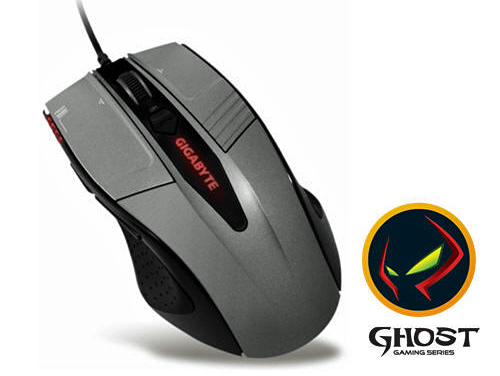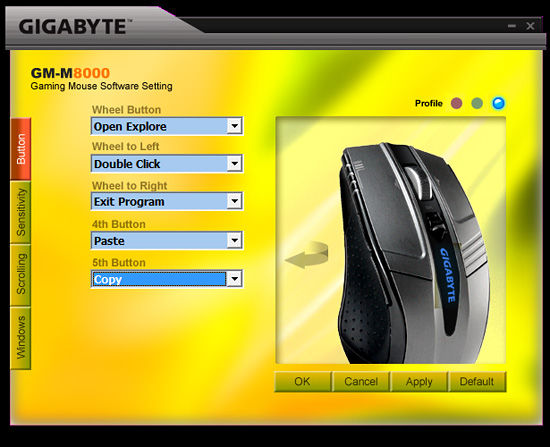Gigabyte GM-M8000 Mouse - A GHOST Story
by Gary Key on June 15, 2009 3:00 PM EST- Posted in
- Smartphones
- Mobile
We have reviewed the features and software capabilities of the Gigabyte GM-M8000 gaming mouse, but what are our real thoughts after using it for the last two weeks?
Hardware

We like the look of this mouse. It is unique in some ways but is not over the top with wild colors or useless buttons tacked on to it. The shape is modern if not a little retro 2005 (is that even retro yet?), sculpted to fit smaller hands, and the colors and materials indicate a high level of quality. While designed with smaller hands in mind, in practice the mouse was quite usable with a claw grip. I still prefer the Logitech G5/MX518 design that fits your full palm area instead of the tapered rear shape of the GM-M8000 but after a short period of adjustment, I learned to live with this design attribute. The adjustable weight system allows a level of customization for the more serious gamers around although we thought the mouse performed better with all 38-grams loaded.
My hand and wrist held up remarkably well in game session testing in World of WarCraft, Sims3, and Company of Heroes. Although my gaming skills are now no better than this squirrel sitting outside my window in Quake or Unreal Tournament, the mouse offered excellent control and response in these two fast-paced games. In fact, the easy gliding ability, braided cord, and layout of the scroll wheels and buttons led us to believe this mouse would be very comfortable for long periods of usage. That assumption turned out to be true although we still believe Gigabyte placed the number 4 button just a little too far forward. Our biggest problem with the ergonomics is the lack of a left-handed version.
Software

The included 1.00 version of the GHOST software was fraught with minor bugs and managed to crash our system a few times in Vista 64, but Vista 32 operation was fine. The updated 1.02 version has proven itself to be very solid, configurable, and we just did not notice any problems throughout testing. Certainly, for the majority of users, this software is one of the more enticing features of the mouse. Otherwise, there is no real reason to purchase it, as the auxiliary buttons will not work in most applications without loading the driver software.
The memory footprint is svelte at 6.5MB compared to the typical 15MB~20MB on other mice. The software offered precise control over the dpi sensitivity including the ability to tailor settings individually on the X and Y-axis . The other options available for customizing how you work or play with the mouse allows for an extremely wide variety of choices on the five programmable buttons. We especially like the ability to create custom Macro assignments. Overall, Gigabyte has provided the user with a solid software package that is close to Logitech’s SetPoint application. We would like to see Gigabyte mimic Logitech’s automatic game profile and setup routines in the future.
Application Performance
There is not a conclusive way of determining which mouse performs best at a given setting in an actual application or game. So it is difficult to state that your gaming abilities will improve with this mouse over the other dozen or so gaming price in the $50 price range. Our test results are based upon working with actual applications and reporting a subjective opinion based on our experiences. We used the mouse in a variety of applications from AutoCad 2009 to Photoshop CS4 to World of WarCraft without an issue.
While gaming in general was very solid and we did not encounter any issues to speak of, the ability to customize our key bindings on an individual basis due to the button count might not satisfy the more fanatical gamer, especially those who play World of WarCraft for a living. Overall, all of the games we tried worked fine and our only hiccup was the slight occasion when the left/right scroll button would not work properly if it was not bound within the game application. We did not see or feel any lag issues during normal operation with the mouse.
We also used the mouse in a variety of applications that included everything from AutoCAD 2009 to Excel 2007, to Photoshop CS4. Our main interest was how well the mouse would handle outlines and pixel by pixel touch up work in Photoshop or line creations in AutoCad. It passed with flying colors as the tracking movement was extremely accurate, especially when we fine tuned the mouse for each individual application.
In Photoshop CS4 we used the lasso tool and could easily outline our images that needed work with precision and during the touchup phase we were able to pinpoint and fill in certain areas with ease. The weight and overall ergonomics of the mouse really allowed us to keep a steady hand while we moved it around a variety of curved surfaces and straight angles. This also held true in other applications like Lightwave 9.6, Cinema 4D R11, and Maya 2009. While this mouse will not replace a pen digitizer or high-end trackball for certain applications, it certainly comes close for us desktop jockeys. Overall, this mouse performed admirably throughout our application testing.
Final ThoughtsOur experience to date with the Gigabyte GM-M8000 has been great. We feel like Gigabyte has offered a solid competitor into the gaming mouse market at a friendly $49.99. After reading the included marketing materials and visiting Gigabyte’s website, we have to say they backed up their words with a mouse that gets the job done. We found the overall design, ergonomics, and quality of materials utilized to be very good. The GHOST Engine mouse software (say that three times fast) package is a great first try from Gigabyte and they certainly provided all the basics one could think of for most users.
Is this GHOST the real thing or a Casper wannabe? I think it is the real thing and with a few improvements to the hardware and software, it could be starring in the next Ghostbusters film. I think the narrow shape towards the rear of the mouse should be widened slightly to address those users that like to palm the mouse (no comments from the bleacher section) or just want added stability when handling the mouse. The number four button is located just a tad too forward unless you utilize the claw method of using the mouse. The GHOST software package is solid although we would like to see auto detection routines and game profile setups for major titles.
So that leaves one last item unanswered. Would I be willing to trade in my beloved G5 for this mouse? I wish my unequivocal answer were yes. However, my personal preference still binds me to the G5 or MX518 based on how well it fits my hand, even though I like the performance of the laser engine in the Gigabyte GM-M8000 far better. I use a mouse about 14 hours a day on average so my deciding factor comes down to comfort first and performance or features second.
If I were a hard core gamer, the improved hardware capabilities of the Gigabyte mouse would be enticing. In fact, after using the GM-M8000 and going back to the G5 in several of the rendering and office applications I almost switched anyway. Who knows, I still might. Would I recommend this mouse to friends and family as a new purchase? My answer is a strong yes if they find the ergonomics to their liking. So, good job Gigabyte on providing users an excellent alternative to Logitech, Microsoft, and RAZER in the gaming market.










44 Comments
View All Comments
jordanclock - Monday, June 15, 2009 - link
Mayhaps you could set up something like this fellow did for objective mouse testing: http://www.esreality.com/?a=longpost&id=126567...">http://www.esreality.com/?a=longpost&id=126567... .Seems like an adequate method to me. A better rig would be able to test multiple directions, but I think that the turn-table method would give a fair representation of the "raw performance" of a mouse.
dvinnen - Tuesday, June 16, 2009 - link
I was going to post the same article.I don't like it when hardware sites review mice as they generally only give a personal opinion on the mouse. While that can be helpful for the feel of the mouse it doesn't truly address the performance of the mouse and seem to harp on the useless features of the mouse. If you are a serious gamer you should be more concern about negative acceleration and acceleration in general then a weight system or on the fly DPI switching.
In the article you talk about the software and the fine-tune DPI changing but ignore the fact that in all likely hood that it is simply adjusting the courser speed which is bad. The reason you have high DPI is so that speed can increase without the increase in aliasing and skipping and loss in precision. This happens when you simply just increase the speed. Who would actually want different X and Y axis speeds anyways?
Generally you want as low of sensitivity as you can stand while in a game for increase aiming precision with no positive acceleration (it screws with consistency of one swipe of your hand) and absolutely no negative acceleration (same problem with consistency but worse as if you swipe to fast the mouse won't track at all and your courser won't move.).
MamiyaOtaru - Tuesday, June 16, 2009 - link
I was going to mention the same thing. DPI over 1600 is overkill for almost anyone, super super high sensitivy gamers excepted. Max speed with perfect control is far more important, and at least at the time of the esreality article, lasers weren't up to snuff in that department.I want to know if a mouse will handle fast movements accurately, not how I can cover 3 screen widths of pixels in one inch.
goinginstyle - Monday, June 15, 2009 - link
Really liked the review and the ZZ Top reference. I actually know something more about this mouse than what is on the Gigabyte website and some other one page reviews. Is there anyway to test the actual USB report rates on an AMD750 chipset to see if there are still lags that were present on the SB600?